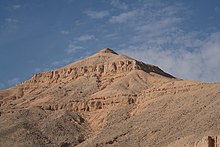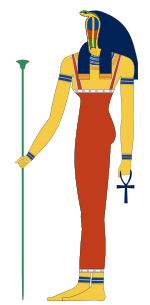Meretseger
| Meretseger in hieroglyphics | ||||||
|---|---|---|---|---|---|---|
Meretseger (Meret seger) Mr.t-sgr She loves silence |
||||||
| or |
Meretsegeret (Meret segeret) Mr.t-sgr.t |
|||||
| Meretseger | ||||||
Meretseger , also Merit-seger , Meresger , Meretsegeret , Mert-sekert is an ancient Egyptian goddess. She was the local goddess of the Theban city of the dead and was especially venerated by the necropolis workers in the workers' settlement of Deir el-Medina . She was an almighty goddess who could help, punish or forgive the inhabitants.
Name and designations
Her name is often rendered as The One Who Loves Silence , The Beloved Of The Silence Maker, or The One Who Loves Silence . However, the name Meretseger is more likely to translate as She loves silence .
Because of its importance Meretseger also has numerous epithets ( epithets ): The large peak of the West Thebes , the magic kingdom ( Weret Hekau ), mistress of the palace or carries the name of their "place of residence", Dehenet-Imentet (summit of the West). Meretseger was also known as the eye of Re .
iconography

The representation of the Meretsegers was very diverse due to their numerous epithets. She was depicted as a woman with a snake head, a snake, or a sphinx with a snake head. Other images also show her as a cow or with a lioness head. Her headdress was a cylindrical fruit measure ( modius ), which could be surrounded by a frieze of urea . Above it were two falcon feathers and now and then the solar disk . But also the Hathor crown, the crown of Lower Egypt or a simple headband adorned the head of the goddess.
Cult and meaning

Originally Meretseger was the sole personification of the Theban necropolis, so that her importance lay primarily in her function as goddess of the necropolis of Thebes, where she was worshiped by the workers. Their most important places of worship were therefore on the west bank of Theban. In the vicinity of the village of Deir el-Medina, for example, there was a rock sanctuary where Ptah and Meretseger enjoyed a cult. Steles from Deir el-Medina (e.g. the stele of the craftsman Neferabu from the reign of Ramses II ; Turin CGT 50058) tell of the dangerous character of the goddess. It also received several small chapels at the foot of the El-Qurn summit . She was also worshiped in some private houses and festivals were held in her honor. A goddess by the name of Hathor-Meretseger was worshiped in Esna .
In the New Kingdom , the worship of Meretseger changed. Especially in the Ramesside period ( 19th and 20th dynasties ) the goddess was worshiped as the personification of a mountain peak that dominates the western bank of Thebes.
See also
literature
- Hans Bonnet : Lexicon of the Egyptian religious history. Nikol, Hamburg 2000, ISBN 3-937872-08-6 , pp. 455-456.
- Richard H. Wilkinson : The world of the gods in ancient Egypt. Faith - Power - Mythology. Theiss, Stuttgart 2003, ISBN 3-8062-1819-6 , p. 224.

